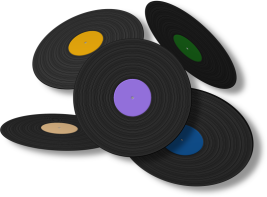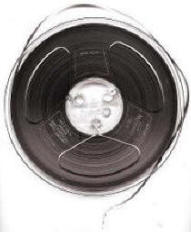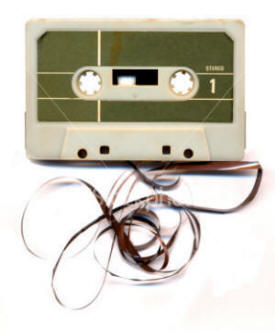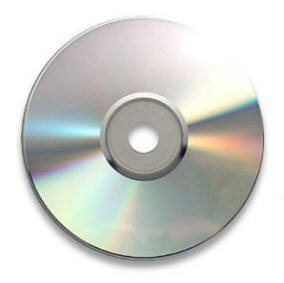You are reading the older HTML site
Positive Feedback ISSUE
november/december 2007
The Joy and
Advantages of Listening to Music from Multiple Formats
by
Teresa Goodwin
What CDs all you have? No? Maybe you also have DVD? Well, let me tell you about the musical bliss that awaits you by expanding your horizons and adopting a multitude of musical formats.
You may be wondering what the advantage would be; after all isn't CD "Perfect Sound Forever"? Even with the vast deluge of titles, a lot of music is not available on CD and may never be. And when it is, the sound quality is often better in another format, often considerably better!
Lots of listeners adopt a single format and rally for it at the exclusion of all others. Some folks call these "format cheerleaders." I call them "format monogamists," as they are loyal to one single format. Then there are those of us who are format polygamists, and we practice "format promiscuity." Remember, music is not like marriage; there is no requirement to be loyal to a single format, nor any laws preventing you from enjoying multiple formats, allowing you new musical and sonic vistas to explore.
My personal Journey from format monogamy to format promiscuity
For decades I was on a quest to find a single format that could offer all the music I love, with realistic sound that was thrilling, enjoyable, and an intense pleasure to listen to. During the 1970s that one format was pre-recorded 7½ IPS Reel to Reel (RTR), which offered excellent sound quality and freedom from the surface noise, pops, and ticks of the LP format. Its drawbacks were audible tape hiss and, on more dramatic material, reverse channel crosstalk and tape print-through (hearing coming dynamic passages during quieter sections of the music). The selection of titles on RTR was smaller than LP, and new releases often came out 6 months or so after the LP release.
Then in the late 1970s I discovered audiophile cassettes at a stereo store that used Advent Process CR/70 cassettes to demo their cassette decks. I was impressed in the extreme. I bought a Luxman cassette deck and nearly the whole catalog of Advent cassettes. I also tried commercial pre-recorded cassette and found the sound quality horrible on the Luxman. A little later I answered a couple of ads in the back of High Fidelity magazine and discovered In Sync Laboratories, Audible Images and Direct to Tape recording company, all of which made real-time duplicated tapes on high quality tape, using 70us equalization. In Sync Labs were made on TDK SA using a bank of Nakamichi cassette decks. I kept reading about Nakamichi, and so I soon traded my Luxman for a Nakamichi. A little later Mobile Fidelity started releasing their High Fidelity cassettes, and I was so sure everything I ever wanted would make it to real time duplicate cassettes that I sold the Reel to Reel and all of my tapes. This was really a bold move, as high fidelity cassettes sold for $15.00 to $18.00 each at time when Reel to Reel and LPs sold for $7.95 - $10.95.
Then in 1983 I was one of the gullible masses that fell for Sony's ads with a picture of a beautiful concert hall and in large print proclaiming "Perfect Sound Forever." I took out an ad in High Fidelity magazine and sold my Nakamich 481 deck and all my pre-recorded cassettes to raise the $900 needed to purchase the first CD player. I impatiently waited for months until the first one, the Sony CDP-101, was available, dreaming about obtaining concert hall realism in my home—I was so thrilled! I bought the first Telarc, M&K Real Time and Columbia-Sony/Japan CDs released. At first I really liked the Telarc and M&K Real Time CDs even though there was coldness to the sound; the lack of noise was impressive. However, after a couple of months I started getting dreadful headaches, and really started noticing the shrillness to the sound texture. After six months I quit listening to music altogether, and traded the Sony CDP-101 in for a Denon receiver to pick up the FM simulcast of MTV and HBO. (This was before Stereo TV.)
It was almost two years later before I got back into recorded music. I bought a turntable for the first time in many years. I didn't go back to audiophile cassettes or reel to reel, as both were dying. The only remaining reel to reel producer, Barclay-Crocker, had announced that they were going out of business, listing competition from CD as the main reason. Analog tape was the refuge for those of us who disliked surface noise, pops, ticks, etc. Now CD came along and offered a different way to avoid these LP maladies. This had the effect of killing the audiophile cassette market, although the commercial major label cassette market continued to grow.
Fast forward to 2007. I have been in and out of many formats, and only last year realized that NO format offered everything I wanted, and that each format has its pros and cons—so I decided I wanted it all. Instead of format dedication, it is format promiscuity I seek. So now I play LPs, Reel to Reels, Cassettes, CDs, SACDs and DVD-Audios. There are things I love and dislike about every format, and music that sounds the best in each format as well. Basically I have found analog recordings to sound the best played on analog formats; digital belongs to digital.
Now let's look at each format on its own: its strengths, weaknesses, ergonomics, and capacity for enjoyment.
Analog Vinyl LPs
When done correctly, nothing short of a real time duplicated Reel to Reel tape can sound as exciting, realistic and beautiful as a well made an analog LP! But only a small percent take full advantage of the format. Prior to the advent of CD, the vast majority of LPs, mostly from commercial major labels, were compromised to make pressing easier and lower the rate of returns from the average consumer who had cheap low quality turntables and cartridges unable to handle heavily modulated grooves. The deep bass was rolled-off and the remaining summed to mono to increase playing time. The highs were rolled-off to decrease noise and distortion extravagated by the poorly made styli used by most listeners of that time. Additionally, the dynamic range was compressed to make LPs sound louder and to make the added noise of recycled vinyl less noticeable.

The least compromised of the commercial LPs were made by companies such as Decca/London, Harmonia Mundi, Lyrita and a handful of others. With the advent of Direct to Disc we really began to hear what the LP format was capable of; the Direct Discs from Sheffield Lab and Crystal Clear to this day remain some of the best LPs ever made. Then Telarc introduced its Soundstream 50kHz Digital LPs, with the infamous "bass drum" heard around the world. Telarc showed that deep, deep bass was possible on LP by accurately spacing the grooves and limiting playing time to less than 23 minutes per side. To this day these recordings remain some of the best that digital has offered. Many are available on SACD as well; the only real objection is the high frequencies, which are less transparent because of the use of a digital recorder. Next Reference Recordings showed us how deep bass could go in a pure analog LP in their famous "Pomp and Pipes" recording. So nowadays deep bass is more common on audiophile LPs.
What I love about LPs is the cream of the format crop, the truly wonderful sounding ones. Most of my LPs are of the audiophile variety but I do have a few commercial ones as well.
Many of my LPs are not available in any other format. For example the many superb Direct to Discs from Crystal Clear, Great American Gramophone/Century, Discwasher, Cardas, RCA Japan, East Wind and others. Except for one Buddy Rich Century title released on SACD by Audio Fidelity, none of these Direct to Disc LPs are available on any other format. Sheffield Lab did release all of their recordings on CD as well, but wouldn't you rather have the original Direct to Disc LP than a CD made from the analog or digital backup tape?
Besides the Direct to Disc LPs my other important LPs include Reference Recordings Pure Analogue Recordings, the RCA Living Stereo remasters by Classic Records, the Mercury Living Presence remasters by Classic Records and Speakers Corner, plus the Decca/London and Harmonia Mundi remasters by Speakers Corner.
Analog 7½ IPS Pre-recorded Reel to Reel
 Reel to Reel at its best
offers the finest and most thrilling sound from my stereo system, with deep,
deep bass and usually extended high frequencies with superb soundstaging. My
best sounding Reel to Reels are the ones duplicated in real time on
mastering tape such as those from Sound Ideas. Also reels from the 1950s - 1960s from such labels as Bel Canto, RCA Living Stereo, Mercury Living
Presence, London/Decca, Audio Fidelity and others, the earliest of these are
also duplicated in Real Time. Remember that there is a lot of great period
popular music that never made it to stereo LP or any other format. That is
because tape had stereo before LP, and thus some titles were released as
mono LPs. When stereo made it to LP, some of these titles were out of print,
making the Reel to Reel the only stereo version.
Reel to Reel at its best
offers the finest and most thrilling sound from my stereo system, with deep,
deep bass and usually extended high frequencies with superb soundstaging. My
best sounding Reel to Reels are the ones duplicated in real time on
mastering tape such as those from Sound Ideas. Also reels from the 1950s - 1960s from such labels as Bel Canto, RCA Living Stereo, Mercury Living
Presence, London/Decca, Audio Fidelity and others, the earliest of these are
also duplicated in Real Time. Remember that there is a lot of great period
popular music that never made it to stereo LP or any other format. That is
because tape had stereo before LP, and thus some titles were released as
mono LPs. When stereo made it to LP, some of these titles were out of print,
making the Reel to Reel the only stereo version.
Most Classical and Jazz commercial major label's Reel to Reel versions were not compressed, or rolled off like the LP versions. So 7½ IPS Reel to Reel is the best way to get recordings from Decca/London, Deutsche Grammophon, Philips and Columbia.
Unfortunately most "Rock" Reel to Reels were recorded at 3¾ IPS and sound totally dreadful to my ears, especially overloaded distorted sound with rolled off highs. There are a few 7½ IPS "Rock" reels and those sound excellent. The original price of the 3¾ IPS reels was $1.00 less than 7½ IPS, I guess they figured that those who liked rock wouldn't be willing to pay the extra dollar? I prefer rock music on cassettes.
The disadvantages of buying used Reel to Reel tapes includes the previous owners improper storage procedures/facilities; the possibility that they were playing tapes with improperly maintained, magnetized heads; and the ugly prospect that they were laying the tapes within strong magnetic fields. In addition, some tapes made during the late 1970s - 1980s using back-coated polyester tape can squeal due to "shredded tape syndrome." I either bid low or look for money back guarantee when I suspect that a tape may not have been well handled. I've done pretty well, though—out of over 150 Reel to Reel purchases, I have returned three, and have thrown another six in the trash due to this sort of invisible damage.
My reel to reel collection is a real musical and sonic treasure—and it is kinda cool watching the reels spin!
Analog Cassette
It's no secret that this is my favorite format. Cassettes may not have the best sound every time, but the shocker is how often the cassette version will beat the LP, CD, DVD-Audio and even sometimes the SACD version! And all this from an itty-bitty format that creeps along at 1 7/8 IPS!
 The reason that faster
tape speeds sound better is because there are more magnetic particles per
second of music. Thus cassette makers using different tape formulas and more
densely packed magnetic particles were, in my opinion, able to get
resolution surpassing 3¾ IPS Reel to Reel at only 1 7/8 IPS on a tape that
is only fractionally as wide. To imagine what a miracle this is, remember
that 3¾ IPS ¼" Reels have four times the tape surface area of a 1 7/8 IPS
cassette.
The reason that faster
tape speeds sound better is because there are more magnetic particles per
second of music. Thus cassette makers using different tape formulas and more
densely packed magnetic particles were, in my opinion, able to get
resolution surpassing 3¾ IPS Reel to Reel at only 1 7/8 IPS on a tape that
is only fractionally as wide. To imagine what a miracle this is, remember
that 3¾ IPS ¼" Reels have four times the tape surface area of a 1 7/8 IPS
cassette.
The best of course are the audiophile cassettes, but since getting a Nakamichi deck I have discovered many commercial major label recordings also sound great, though to a lesser degree. I am sure audiophile labels will sound great on any quality cassette deck that's properly adjusted, but I cannot say the same about the ones from commercial labels, as these sounded terrible on the Luxman I had in the late 1970s. I never tried commercial cassettes on the Nakamichi 481 because of their poor performance on the Luxman. However, before acquiring my current Nakamichi CR-1A I had build up a large collection of commercial cassettes I played in my Kenwood car deck, and was shocked at how good they sounded through the Nakamichi CR-1A!
Cassette is the format where Rock music sounds the absolute best, and it is the format in which I experience the most goose bumps! My Nakamichi deck is only a 2-head unit, and I keep the azimuth aligned. The deep bass, the liquid midrange, and the sonic realism on most cassettes is amazing, and the high frequency response is only surpassed by Reel to Reel and the better LPs and SACDs.
Pre-recorded cassettes are also the safest format to buy used; I have only bought one that had damage from a stray magnetic field. Plus, no matter what label the cassette is on it usually sounds good. The only ones I reject are the ones in which I do not like the music. I play pre-recorded cassettes more than any other format.
CD
CD can—and more often than not, does—sound totally dreadful. I have finally gotten CD playback to acceptable level in my system, where the best CDs are listenable, and often enjoyable. But most CDs still suffer from incorrect timbres of recorded musical instruments coupled with gross upper midrange shrillness and rolled-off high frequencies, making violins sound edgy and spiky, and high percussion instruments sound subdued.
On the other hand, CDs
from such companies as Telarc and Reference Recordings often sound very
good. Now that I have acceptable CD playback, it is nice to enjoy those
recordings that are not available on any other format. I have to say it,
though: CD is my least favorite format.
SACD
I love the sound of SACDs, especially those PURE DSDs from Telarc's classical division. This is the most analog sounding of all digital formats. But there are bad SACDs as well; for example the LSO Lives, which to my ears sound as bad as the worst CDs—and that despite the fact that they are recorded in DSD. (Some blame the concert hall and the microphone techniques.) Plus, all too many SACDs are from low-resolution PCM masters that also sound poor. No surprise.
In the past I have quit SACDs due to reoccurring "TOC" reading problems of hybrid discs. I am hoping this problem is solved now.
I have my player set to 2-channel stereo and it picks the 2-channel program for me and starts playing as soon as I put in the SACD.
DVD-Audio
DVD-Audio can sound excellent as well, although it is a pain sometimes to find the 2-channel recordings, as you usually have to turn on the TV and select it from the menu.
Most DVD-Audios are from analog masters which sound better on LP or Reel to Reel, but there are some excellent original 24 Bit 96kHz ones from AIX.
How I find my music
It is databases that make collecting multiple formats possible for me. Since all these formats are different sizes, they cannot be stored together. I believe that this is another reason I believe most people try to stick with one format, as they are the same size and a music lover can just arrange everything alphabetically and can easily find what they want to play.
It's not as easy with multiple formats. So unless I remember which format a recording is in, I can get pretty frustrated. But not with a good database! I use Microsoft Access Music Collection 1, modified for the information I want to save on each recording. This is coupled with a Microsoft Word document listing all my Classical works, arranged by composer and the record number they are on. Here is an example of my first entry:
ADAM, ADOLPHE (1803-1856)
Le Diable A Quatre Ballet
Bonynge, London Symphony Orchestra [4 Track 7½ IPS RTR] London ffrr / Ampex LCL-80171
If I Were King: Overture (1852)
Agoult, New Symphony Orchestra of London [LP] RCA Living Stereo / Classic Records LSC-2134
By this I would know that the "Le Diable A Quatre" ballet is under "Adam" in my Reel to Reel rack. To find the "If I Were King," I would go to my Music Collection database and look up LSC-2134
|
Title |
Artist | Label | Format | Purchase Price |
OVERTURE! OVERTURE! |
Raymond Agoult, New Symphony Orchestra of London |
RCA Living Stereo / Classic Records LSC-2134 |
LP |
$14.18 |
Thus I would know it was under "OVERTURE! OVERTURE!" in my LP rack.
I would be lost without a database, and likely unable to enjoy music nearly as much on multiple formats. (If you're going to try what I'm doing, I recommend that you plan on coming up with some sort of database method so that you can track what you have, and what format it is in.) Since I have nearly every consumer format except 8 Track, I have been able to find 99% of the music I love. And because I also have high-resolution digital formats, I can discover new music and of course I am always discovering music that's new to me on the various legacy analog formats.
Multiple formats open up many audio vistas that were previously closed to me, due to the fact that I was concentrating on a single format. Now I go for the music wherever I can find it!
And in the end, it is all about music, isn't it?
